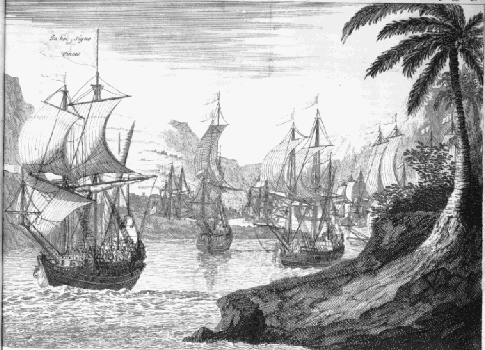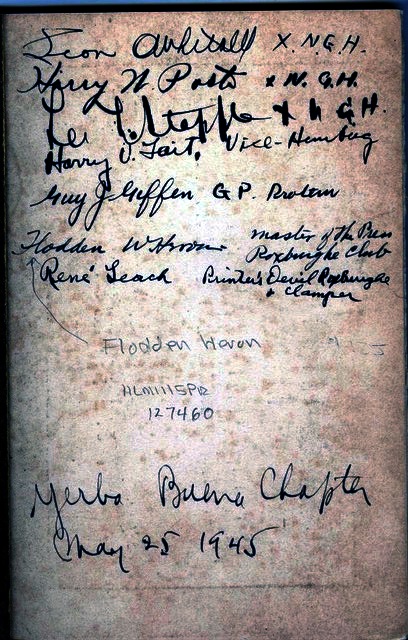Secret of Drake Hoax revealed after 70 years


 Society's prank on UC professor went awry
Society's prank on UC professor went awry
The last secret of one of the greatest historical hoaxes in the history of the West has finally been revealed -- it was a joke pulled on an eminent UC Berkeley professor by members of E Clampus Vitus, which describes itself as either a historical drinking society or a drinking historical society.
It involves the mysterious "Plate of Brasse" supposedly left by Sir Francis Drake in Marin County 424 years ago when he claimed what he called New Albion for England. The plate was discovered near San Quentin prison in 1936 and hailed by Professor Herbert Bolton as "one of the world's long-lost treasures. " He called it authentic "beyond all reasonable doubt."
Bolton died in 1953, full of years and honors. The plate was accepted as genuine until 1977 when new tests showed it to be a forgery -- for one thing, the brass had been rolled in the 20th century, not the 16th. It was a huge embarrassment for the university and the historical community.
There was one last mystery: No one knew who was behind the hoax or why.
Now, four historians writing in the official magazine of the California Historical Society say they have figured it out -- the brass plate was a practical joke played on Bolton by several of his colleagues who were members of the Ancient and Honorable Order of E Clampus Vitus, an organization that mixed history with strong drink and jokes.
Bolton himself was a Clamper, with the title of Grand Royal Historian of the group's Yerba Buena chapter.
According to the article, which appears in the current issue of California History magazine, G. Ezra Dane -- a man who claimed his first name was "Gee- hosaphat" -- and four other Clampers knew that Bolton, a leading expert on Drake and his times, was convinced that a brass plate that Drake had fastened to a post near Point Reyes in 1579 was still to be found.
They decided to find it for him, obtained a brass plate in an Alameda ship chandlery, and covered it with authentic looking writing from the Elizabethan era.
They also daubed the back of the plate with the letters "ECV" in transparent fluorescent paint and dumped it at Point Reyes sometime in the early 1930s.
PLOT WENT AWRY
But then the plot went awry. A man did pick the plate up, carried it in his car for a while and threw it away near San Quentin, where it was found three years later by a shop clerk named Beryle Shinn, who kept it for several months and then brought it to Bolton at his Berkeley office. Almost immediately, Bolton accepted it as genuine. He became determined to acquire the plate from Shinn and then tell the world.
According to the historians Raymond Aker, Robert Allen, James Spitze and Edward Von der Porten, the men realized their "inside joke, intended to be resolved with a good laugh over a dinner table or a Clamper meeting, had escaped from their control."
Bolton, the historians wrote, "was too excited by the find to be cautious." More careful historians, said Kevin Starr, the author of a number of books on California, would have realized the find "was too good to be true."
Bolton was familiar with the Clamper motto: "Credo Quia Absurdum," which means "I believe because it is absurd." But the "ECV" lettering had escaped notice, and he did not think of the Clampers.
The realization that Bolton had swallowed the story hook, line and sinker, the four historians wrote, "must soon have changed their jubilation to shock and -- quickly -- deep concern."
The conspirators all knew Bolton, and they were trapped: They were in too far to back out.
They dropped a few hints -- including a fake second plate featuring an announcement by "The Great Hi-oh" of the Miwok tribe -- and a couple of other odd announcements, but Bolton never wavered. So they kept the conspiracy secret.
CONSPIRATORS NOW DEAD
All of the conspirators are dead, but in their old ages, perhaps troubled by conscience, they told bits and pieces of the story.
Eventually, the four historians, connected the clues, a task that took 11 years. Their scholarly essay in California History is so carefully researched that it has 61 footnotes.
"We knew the plate was a forgery," said Von der Porten. "What had remained a mystery is who made the plate and why."
There always remains the possibility that the tale of the hoax may in itself be a hoax, like a riddle inside an enigma.
"That had occurred to us," Von der Porten said. "We did use a very large number of sources, and I think we have got it straight."
Starr said Friday he wasn't surprised by the story and that the revelations were a cautionary tale.
"Every one of us is vulnerable to something like this," he said. "Professor Bolton believed it because he wanted to believe. But it does not detract from his work.
"Bolton lives on in his wonderful books. And Drake and the great seamen of that time -- Magellan, Cabrillo and the others -- can still be honored for their achievements even in the midst of a joke."
